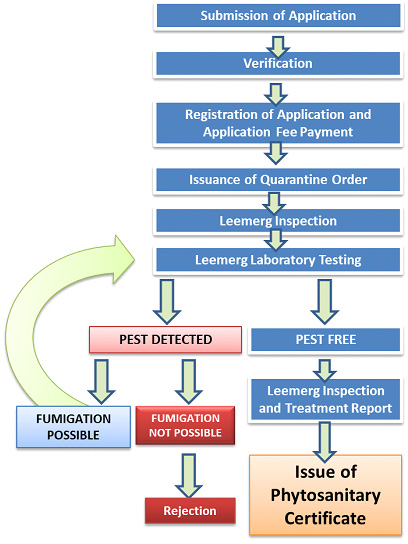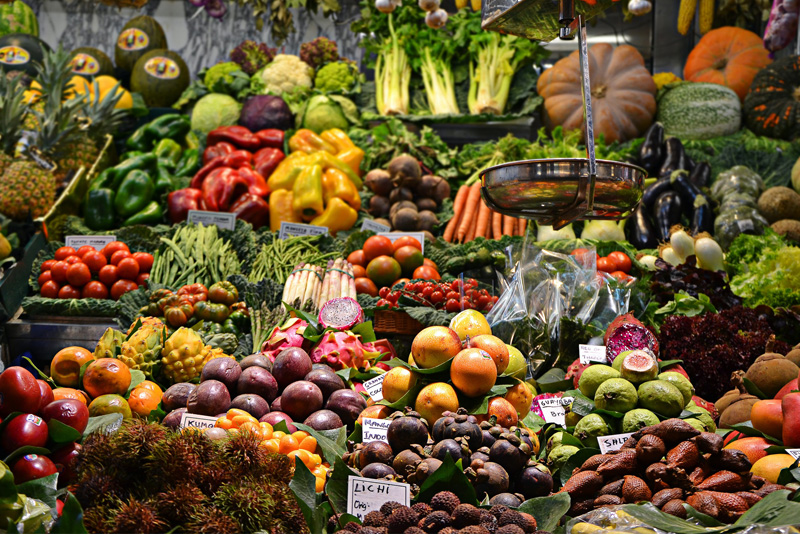



NPPO has identified a list of Plants/ Plant Products & other Regulated Articles in the SOP for Export Inspection and Phytosanitary Certification published on the DPPQS website. The process/criteria of inspection, guidelines for type, size of samples to be inspected and recommended testing procedures are highly specific to each of these articles:
| S. No. | Commodity |
|---|---|
| 1 | Seeds for Propagation |
| 2 | Nursery Stock and other propagating plant material |
| 3 | Tissue Culture plants for Propagation |
| 4 | Bulbs, Tubers, corms, rhizomes and other underground roots for propagation. |
| 5 | Milled Products for Consumption |
| 6 | Grains, pulses and other seeds for consumption |
| 7 | Fresh fruits, berries and vegetables for consumption |
| 8 | Cut flowers, branches and foliage for decorative purposes |
| 9 | Potatoes |
| S. No. | Commodity |
|---|---|
| 1 | Growing Media |
| 2 | Packaging Material |
| 3 | Cargo Containers |
| 4 | Transport Vehicles (Trucks/ Wagons) |
| 5 | Ships and Other Vessels |
| 6 | Storage Places. |
| 7 | Farm Equipments / Machinery. |
| 8 | Biological control agents/other Beneficial Organisms & Pests |
International Plant Protection Convention (IPPC) is an intergovernmental treaty signed by more than 180 countries under the Food and Agriculture Organization of the United Nations. It aims to protect cultivated and wild plants by preventing the introduction and spread o f pests through international movement of plants, plant products and other regulated materials.
The International Standards for Phytosanitary Measures (ISPM) is a set of standards set by the IPPC governing processes of Phytosanitary Inspection and certification of consignments of plants, plant products and other regulated articles at import and export.
At the National Level, member nations of the IPPC have created National Plant Protection Organizations (NPPO). Among other activities, NPPO are responsible for “the inspection of consignments of plants and plant products moving in international traffic and, where appropriate, the inspection of other regulated articles, particularly with the object of preventing the introduction and/or spread of pests” (Article IV.2(c) of the IPPC).
In India, Directorate of Plant Protection, Quarantine & Storage (DPPQS), NH-4, Faridabad under Department of Agriculture, Cooperation & Farmers Welfare, Ministry of Agriculture & Farmers Welfare Government of India acts as NPPO.

Based on the standards prescribed by the IPPC, DPPQS maintains a set of standards of Phytosanitary Inspection and certification called the “National Standards for Phytosanitary Measures (NSPM)” All items of export from India are subject to procedures, rules and guidelines stipulated in this document.

| Additional declaration | A statement that is required by an importing country to be entered in Phytosanitary Certificate and which provides specific additional information pertinent to the phytosanitary condition of a consignment. |
| Authorised Officer | A technical officer of state/central government organisation authorised to issue phytosanitary certificate |
| Biological control agent | A natural enemy, antagonist, competitor or other organism used for pest control |
| Bulbs & Tubers | A commodity class for dormant underground parts of plant intended for planting (includes corms and rhizomes). |
| Certificate | An official document which attests to the phytosanitary status of any consignment affected by phytosanitary regulations. |
| Commodity | A type of plant, plant product, or other article being moved for trade or other purpose. |
| Compliance procedure | Official procedure used to verify that a consignment complies with stated phytosanitary requirements. |
| Consignment | A quantity of plants, plant products and/or other regulated articles being moved from one country to another and covered by a single phytosanitary certificate (a consignment may be composed of one or more lots). |
| Consignment in transit | A consignment that is not imported into a country but passes through it to another country, subject to official procedures which ensure that it remains enclosed, and is not split up, not combined with other consignments nor has its packaging changed. |
| Country of origin (of a consignment of plant products) | Country where the plants from which the plant products are derived were grown. |
| Country of origin (of a consignment of plants) | Country where the plants were grown. |
| Country of origin (of regulated articles other than plants and plant products) | Country where the regulated articles were first exposed to contamination by pests. |
| Country of re-export | Country into which a consignment of plants, plant products, or other regulated articles have been imported and was stored, split up, had its packaging changed or was otherwise exposed to contamination by pests, prior to a third country. |
| Cut flowers and branches | A commodity class for fresh parts of plants intended for decorative use and not for planting. |
| Devitalization | A procedure rendering plants or plant products incapable of germination, growth or further reproduction |
| Dunnage | Wood packaging material used to secure or support a commodity but which does not remain associated with the commodity. |
| Field | A plot of land with defined boundaries within a place of production on which a commodity was grown. |
| Fruits and vegetables | A commodity class for fresh parts of plants intended for consumption or processing and not for planting. |
| Fumigation | Treatment with a chemical agent that reaches the commodity wholly or primarily in gaseous stage. |
| Germplasm | Plants and plant material intended for use in breeding or conservation programmes |
| Grain | A commodity class for seeds intended for processing or consumption and not for planting. |
| Import Permit | Official document authorizing importation of a commodity or of a biological control agent in accordance with specified phytosanitary requirements. |
| Inspection | Official visual examination of plants, plant products or other regulated articles to determine if pests are present and/ or to determine compliance with phytosanitary regulations. |
| Inspector | A trained technical staff assigned with the responsibility of inspection/sampling of consignments of plants/plant products and other regulated articles for phytosanitary certification or a person authorised by the Dte of PPQS (NPPO) to discharge its functions. |
| IPPC | International Plant Protection Convention, as deposited in 1951 with FAO in Rome and as subsequently amended. |
| International Standard for Phytosanitary Measures (ISPM) | An international standard adopted by the conference of FAO, the interim commission on phytosanitary measures or the commission on phytosanitary measures established under IPPC. |
| Issuing authority | Any officer notified by the Government of India in the Gazette, for the purpose of issuance of phytosanitary certificate. |
| Lot | A number of units of a single commodity, identifiable by its homogeneity of composition, origin etc., forming part of a consignment. |
| National Plant Protection Organization (NPPO) | Official service established by a government to discharge the functions specified by the IPPC. |
| NSPM | National standard for phytosanitary measures established by Dte of PPQS |
| Official | Established, authorized or performed by a National Plant Protection Organisation. |
| Pest | Any species, strain or biotype of plant, or pathogenic agent, injurious to plants or plant products. |
| Phytosanitary Certificate | Certificate patterned after the model certificates of IPPC. |
| Phytosanitary certification | Use of phytosanitary procedures leading to the issue of a Phytosanitary Certificate. |
| Phytosanitary regulation | Official rule to prevent the introduction and/ or spread of quarantine pests or to limit the economic impact of regulated non-quarantine pests including establishment of procedures for phytosanitary certification. |
| Plant products | Unmanufactured material of plant origin (including grain) and those manufactured products that, by their nature or that of their processing, may create a risk for the spread of pests. |
| Plants | Living plants and parts thereof, including seeds and germplasm. |
| Quarantine Pest | A pest of potential economic importance to the area endangered and not yet present there, or present but not widely distributed and being officially controlled. |
| Regulated article | Any plant, plant product, storage place, packaging, conveyance container, soil and any other organism, object or material capable of harbouring or spread of pests deemed to require phytosanitary measures, particularly, where international transportation is involved |
| Regulated non quarantine pest | A non-quarantine pest whose presence in plants for planting affects the intended use of those plants with an economically unacceptable impact and which is therefore regulated within the territory of the importing contracting party. |
| Seeds | Seeds for planting or intended for planting and not for consumption or processing |
| Stored product | Un-manufactured plant product intended for consumption or processing stored in a dried form. |
| Treatment | Official procedure for the killing, inactivation, or removal of pests or for rendering pests infertile or for devitalization. |
| Visual Examination | The physical examination of plants, plant products, or other regulated articles using the unaided eye, lens, stereoscope or microscope to detect pests or contaminants without testing or processing |
Export Inspection Manual, PQ-15 (1999), Dte of PPQS, Faridabad Export Certification System, ISPM 7 (1997), FAO, Rome Glossary of Phytosanitary Terms, ISPM 5 (2006), FAO, Rome. Guidelines for Phytosanitary Certificates, ISPM 12 (2001), FAO, Rome. Guidelines for Inspection, ISPM 23 (2005), FAO, Rome. International Plant Protection Convention, 1997, FAO, Rome. Phytosanitary Accreditation Manual for Seed (2005), Dte of PPQS, Faridabad.